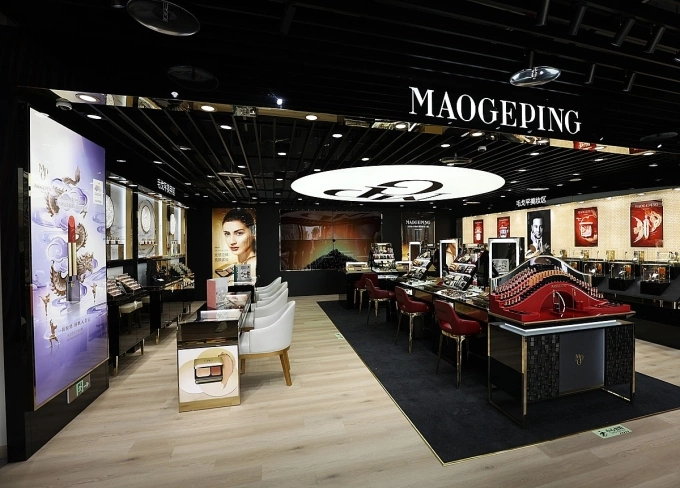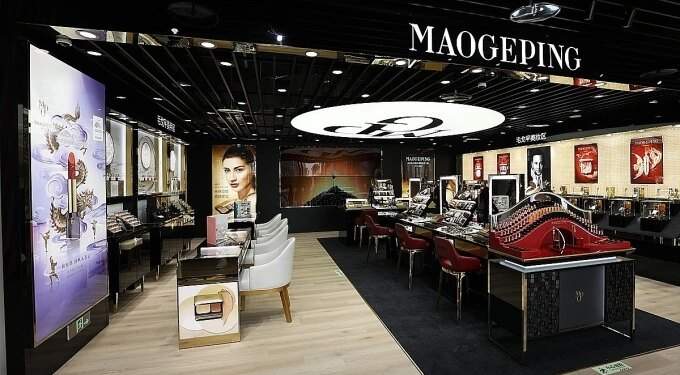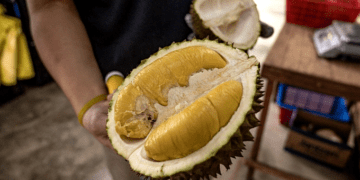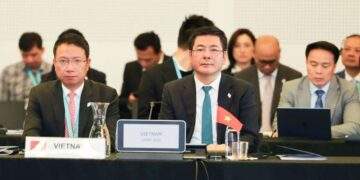Five Chinese prestige brands across handbags, apparel, fragrance, cosmetics, and jewelry have outpaced seven foreign competitors in sales growth over the past two years, according to data from BigOne Lab analyzed by Bloomberg News.
 |
|
A Mao Geping Cosmetics store in China. Photo courtesy of Mao Geping Cosmetics, |
Laopu Gold’s e-commerce sales surged more than 1,000% in the first three quarters of this year compared with two years ago, while Songmont’s online handbag sales climbed about 90%.
Meanwhile, online bag sales for Gucci in China dropped more than 50% and Michael Kors’ fell roughly 40%.
Other local brands, Mao Geping Cosmetics, perfumer To Summer, and clothing label ICICLE, have all seen similar success in their segments.
On Tmall, China’s largest e-commerce marketplace, revenues for some domestic names match or exceed those of Western brands.
Laopu generated US$630 million in Tmall sales in the 12 months to October, compared with US$57 million for Van Cleef & Arpels, according to consultancy Hangzhou Zhiyi Tech.
Mao Geping recorded $125 million in revenue, more than twice that of Bobbi Brown. For Laopu Gold, total sales (both offline and online) rose 250% in the first half of this year, after doubling in 2023 and again in 2024, according to its financial reports.
At the same time, Bain estimates that China’s luxury market, long dominated by European groups including LVMH Moet Hennessy Louis Vuitton, Kering, and Burberry, contracted by as much as 20% last year, the sharpest drop since at least 2011.
The rise of Chinese brands has caught the attention of foreign players.
Johann Rupert, chairman of luxury jewelry brand Cartier’s parent company Richemont, was asked in May whether Laopu was a threat.
The brand is “tied to nationalism and tied to patriotism, and they have a lot of wins in their favor,” Rupert said, as reported by The Wall Street Journal. However, he added, “Cartier is universal.”
Even Bernard Arnault, one of the world’s wealthiest individuals and chairman of LVMH, visited local brands’ stores and bought handbags when he was in Shanghai in September, sources told Bloomberg News.
Chinese brands have been becoming more competitive for pursuing a sound strategy that meet customers’ practical demand.
Laopu’s chairman, Xu Gaoming, told shareholders in April that the company has secured a niche with limited direct rivals.
He said Chinese gold jewelers typically target the mass market, while European fine jewelry houses do not focus on gold.
Prices also play a key role in convincing luxury goods buyers to change their brands.
Sophia Zhang, 32, had long been a devoted buyer of Lancôme and Estée Lauder before becoming a fan of Mao Geping, the namesake brand created by a Chinese makeup artist.
The brand’s creams and foundations typically cost half or even less than comparable international products. A 100-gram jar of its signature moisturizer sells for $139, versus $280 for a smaller jar of a premium Lancôme moisturizer.
“In the past I figured I’d splurge on skin care, believing those big names were the best, and I’d dismiss local products just because they were cheaper,” said Zhang, who noted that she still purchases some European brands.
Now that she has found a more affordable option that works for her, she said, “it’ll be tough to go back.”
China’s deteriorating economy has eroded demand for global luxury brands. Instead of rebounding after the lifting of strict Covid controls, spending on international labels has slumped.
Shares of major luxury houses have been hit hard: LVMH is down around 30% from its 2023 peak while Kering has fallen roughly 60% since its 2021 high in Paris.
But price alone is not the key factor, said Jacques Roizen, managing director of China consulting at Digital Luxury Group.
“Contrary to common perception, Chinese beauty brands aren’t competing on price – they are building rich brand universes and prioritizing storytelling,” Roizen said.
“For Western prestige beauty brands, the rise of local competitors should serve as both a wake-up call and a warning.”
Christine Cui, a fashion insider based in Shanghai, highlighted development potential for domestic handbags.
“Consumers are no longer chasing logos, but are more focused on value for money,” she said, as reported by China Daily.
“Our domestic handbags are on par with international light luxury brands in terms of aesthetics and materials. If international luxury brands do not innovate in design and continue to emphasize only their brand logos, they will inevitably face significant challenges.”
For consumers such as Wan Yihuan, a 30-year-old finance professional in Shanghai, the message resonates.
A former Hermès and Tom Ford enthusiast, she now uses a $210 Songmont hobo bag and wears Mao Geping makeup.
“I fell into the trap of consumerism when I was younger,” she said. “Now I just want things I truly like.”





